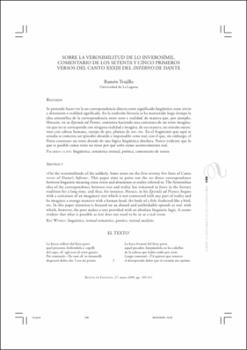Sobre la verosimilitud de lo inverosímil. Comentario de los setenta y cinco primeros versos del canto XXXIII del Inferno de Dante
Autor
Trujillo Carreño, RamónFecha
2009Resumen
Se pretende hacer ver la no correspondencia directa entre significado lingüístico sensu stricto y denotatum o realidad significada. En la tradición literaria se ha mantenido largo tiempo la idea aristotélica de la correspondencia entre texto y realidad, de manera que, por ejemplo, Horacio, en su Epistula ad Pisones, comienza haciendo una caricatura de un texto imaginario que no se corresponde con ninguna realidad e imagina, de esa manera, un extraño monstruo con cabeza humana, cuerpo de pez, plumas de ave, etc. En el fragmento que aquí se
estudia se comenta un episodio absurdo e impensable como real, con el que, sin embargo, el Poeta construye un texto dotado de una lógica lingüística absoluta. Parece evidente que lo que es posible como texto no tiene por qué serlo como acontecimiento real. This paper aims to point out the no direct correspondence
between linguistic meaning sensu stricto and denotatum or reality referred to. The Aristotelian
idea of the correspondence between text and reality has remained in force in the literary
tradition for a long time, and thus, for instance, Horace, in his Epistula ad Pisones, begins
with a caricature of an imaginary text which is not connected with any part of reality and
he imagines a strange monster with a human head, the body of a fish, feathered like a bird,
etc. In this paper attention is focused on an absurd and unthinkable episode as real, with
which, however, the poet makes a text provided with an absolute linguistic logic. It seems
evident that what is possible as text does not need to be so as a real event.





